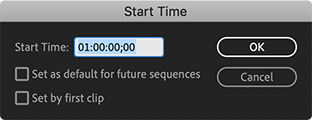Tip #251: Change the Sequence Starting Timecode
… for Adobe Premiere Pro CC
Tip #251: Change the Sequence Starting Timecode
Larry Jordan – LarryJordan.com
New options allow you to set a timecode default.


Timecode is a label for every frame of video in a clip, or the sequence itself. It’s composed of four pairs of numbers representing HOURS:MINUTES:SECONDS:FRAMES. Every frame in a clip has a unique timecode associated with it.
Think of timecode as the address of a house, it allows us to quickly find any frame in a clip. (Timecode can match between clips, in which case, an NLE can tell which frame is in which clip by combining the timecode with the clip name and its path.)
NOTE: For those who need to deal with drop-frame vs. non-drop-frame, the difference is the last colon. If the last symbol is a colon (:), the clip is non-drop-frame. If the last symbol is a semi-colon (;), the clip is drop-frame.
By default, the starting timecode for a sequence is 00:00:00:00. However, there are times when you need to change it; for example, sequences destined for broadcast.
To change the starting timecode:
- Click the 3-line “stacked pancakes” immediately to the right of the sequence name in the Timeline.
- Enter the starting timecode for the sequence.
- Check Set as default for future sequences if you want to make this the default setting.
- Check Set by first clip if you want the sequence to inherit the timecode of the first clip you edit into the sequence.
EXTRA CREDIT
While it’s possible for timecode to match time of day, most of the time it does not. Don’t get confused. Timecode is a label expressed as time, not a time-of-day reference.


Leave a Reply
Want to join the discussion?Feel free to contribute!